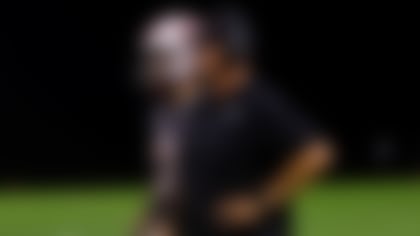By Bill Bradley, contributing editor
NFL vice president of officiating Dean Blandino said Friday that it is normal for referees to direct players prior to the snap of the ball as was the case during Thursday's game-ending field-goal attempt in the New England Patriots' 27-25 victory over the New York Jets.
Speaking during his weekly officiating video for the media, he said that the umpire tapped Patriots linebacker Dont'a Hightower to remind him that he cannot line up over the center, who for the past two seasons has been considered a defenseless player on field-goal attempts.
"This is nothing unusual," Blandino said. "It's a player safety rule in terms of protecting the center who's in a defenseless posture, so if we can prevent that contact, we will.
"Typically, you'll see officials work with the players on formations. It's like the line of scrimmage official pointing out the line to the wideout that is trying to get lined up correctly. This is a standard officiating mechanic, and there isn't anything that unusual about it."
During the video, Blandino showed examples from this season of referees either tapping players to move from over the center or showing them a lane that has to be free in front of the center.
The rule change occurred prior to the 2013 season when the line-overload rule was passed. That rule prevents defenses from putting more than six players on one side of the line to flood the offense on place kicks as well as freeing up space in front of the center.
The rule gained notoriety a year ago when the Jets received new life against the Patriots, who were flagged for the player safety rule. The rule helped the Jets move 15 yards closer and kick a game-winning field goal.
Blandino also examined a replay review of a one-handed catch by wide receiver Eric Decker near the end of the first half in the Jets' loss to the Denver Broncos last Sunday.
"The key is: When does the player gain firm control of the football?" Blandino said. "That's what you have to establish first, then look at the feet.
"The ball is loose at that point. He doesn't have firm control when he puts his hand up. When he does bring it into his body and he does have control of the ball, look at where the left foot is. It's not on the ground. This isn't a complete pass. It was the correct call on the field and properly handled in replay. ... He has to have clear control of the football."
Blandino also pointed out that the St. Louis Rams tried to run a "hideout play" against the San Francisco 49ers on Monday similar to what the Cleveland Browns tried two weeks ago. The Browns were told they committed two rules violations in the play.
However, the Rams' version was legal, Blandino said. This time, the player in question was Rams quarterback Austin Davis, who lined up in along the sideline, facing his team, on a fourth-down play.
"An offensive player can line up less than 5 yards from the sideline provided he's not in his team's bench area," Blandino said. "If he's in his team's bench area (which begins at the 32-yards lines), that's going to be an attempt to deceive the defense.
"If he was inside the 32, it would be a foul; outside the 32, it's not a foul. This is a legal play. Also, he is facing his team, which is legal when you're not on the line of scrimmage."



